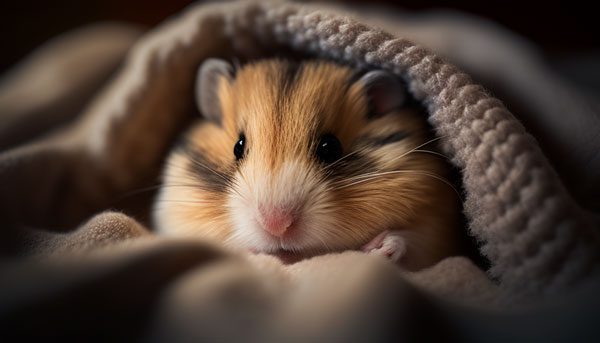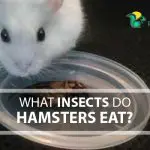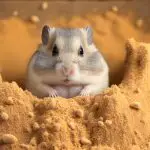Do Hamsters Eat Their Bedding? How to Make It Stop?
People nowadays love to pet different types of animals. But they become worried about some behaviors which are normal to them.
So, do hamsters eat their bedding? How to make it stop? No. Hamsters are not willing to eat their bedding. They just chew it to remove their stress and boredom or to sharpen their teeth. It is a normal fact. You cannot just stop them from chewing bedding, but you can keep them busy doing other stuff or let them chew healthy bedding.
In this article, we have discussed everything about their bedding, how to stop them and what kind of bedding they can chew. Keep reading to get all the information for the sake of your pet’s health.
Do Hamsters Eat Their Bedding?
No, hamsters do not engulf their bedding. Rather they chew the bedding and bring it to their residence for more comfort. Hamsters have pouches in their mouth that they use for different purposes.

They store things like food, bedding, and other things in the mouth. Even they carry their babies in the pouch in case of danger. They use the pouches as a backpack. Hamsters can also fill their pouches with air to float better if they need to swim to escape danger.
If you see your hamster staffing beddings into their cheeks, don’t worry yourself. This incident seems like eating bedding, but they don’t eat these things.
Why Do Hamsters Chew Their Bedding?
Hamsters chew their bedding for some purpose or no reason. If they are doing it more than usual, these could be the reason behind it:
- They are stressed
- For sharpening their teeth
- They are curious about the bedding
- To remove boredom
- To use it in their nest for more comfort
If you are still conscious about chewing the bedding, learn about the wrong and right bedding. Wrong bedding can cause harm to them, which is not safe. On the other hand, good bedding means that it is not harmful to their body.

Healthy Bedding and Unhealthy Bedding for Hamsters
So, as your hamsters won’t stop stealing the bedding into their pouches, it is better to ensure they get safe bedding always.
Unhealthy Bedding
There are several types of unhealthy beddings you should avoid using for your hamsters.
Cat litter
Cat litter is not good for hamsters. It contains chemicals and is rough in texture. So, it can create problems in their digestive system. Also, they can get stuck while swallowing due to less moisture. So, it is better not to use cat litter as bedding.
Pine, Cedar Wood Shaving, and Areca Nut
Not all wood shavings are bad. But pine and cedar wood shavings are prohibited for your little friend. They contain substances like essential oil, which is hazardous for your hamster’s life.
If they chew pine or cedar wood shavings, the essential oil can contaminate their saliva and cause life-threatening conditions. You should keep your hamster away from Areca nuts as well. Areca nuts cause diseases and hamper their pouches.
Printed Papers
Newspapers, books, or printed paper contain ink. Ink is harmful to both humans and pets. So it is better not to use any paper which contains ink.
Cotton
Cotton is also not safe for hamsters as it can get stuck in the teeth and also during swallowing. Your hamster can get disturbed if its legs or teeth get trapped in it.

Straw
Straw can injure hamsters’ cheek pouches. Also, your hamster will not feel comfortable with straw breeding. It can hamper your pet both internally and externally.
Cloths
Cloths seem safe, but it is also unsafe. Your hamster may swallow it, which can cause difficulty in digestion. Also, it can get stuck in its throat.
Healthy Bedding
Following are some healthy beddings you may consider for your hamsters.

Toilet Paper Or Tissues
Toilet paper or tissue paper is soft and has no hazardous effect. If your hamster swallows toilet paper, it can easily digest it. Also, it gets softer when it comes in contact with water. So, there is no chance of getting stuck into your pet’s throat or teeth. But while using this paper, you should tear it into small pieces.
Aspen Shaving
Aspen shavings contain no harmful chemicals. Your hamster mainly uses their bedding to make their living area comfortable. Aspen shaving can give them that comfort and they can use it to make small tunnels. If your pet eats aspen shaving by mistake, it will not create any problems and be expelled by waste products.
Chewing the bedding is normal. But if you notice that your hamster is chewing the bars, that is not normal. It is more harmful than chewing the wrong bedding. Also, changing the old bedding and cleaning the cage is important. That will help them to keep away from fungus and bacteria.
What To Do If Your Hamster Swallows Their Bedding?
As the hamsters chew the bedding, it is normal that they eat or swallow these things.

- If you notice chewing them with the wrong substance or wrong bedding, take them to the vet as soon as possible
- Also, regular check-ups can detect hamsters’ health problems early
Wrong bedding can cause breathing problems. But those symptoms mostly arise when it is too late. So if you have any confusion related to the bedding, follow the experts’ opinion.
How to Stop Your Hamster From Chewing Their Bedding?
You can not keep them away from chewing the bedding. Rather you can keep them busy doing other stuff for less chewing and remove them from stress. For example,

- Increase the cage size
- Give them a lot of chewable toys
- Place their cage far from loud noise. They love to stay in a calm and peaceful area
- Change out the cage layout
- Give them playing elements
- Rearrange their housing elements
- Give them plenty of food
- Give them a hamster wheel or hamster ball for refreshment
- Take your hamster out of the cage a few times daily
Follow these methods to keep them busy in playing and eating. If you find toys and bedding expensive, you can create DIY toys and bedding.
If you’re concerned about your hamster’s behavior, you may find our articles on how to bathe your hamster and why your hamster may be squeaking useful. Our article on how to bathe your hamster provides step-by-step instructions on how to keep your hamster clean and healthy. Meanwhile, our article on why your hamster may be squeaking explains the potential reasons why your hamster might be making this noise and what it might mean.FAQs
Take a look at the questions commonly asked by people about hamsters’ bedding.
Q: How many times should I clean my hamster’s bedding?
You should clean your hamster’s bedding once a week. It is important and good for their health. The bedding gets contaminated as the hamster eats and drinks in its cage. That will invite bacteria and fungi. So maintaining hygiene is a must for good health.
Q: Do hamsters need bedding?
Yes. Hamsters need bedding. They use the bedding to rest on it comfortably. It can make them warm. They love to dig and make tunnels using bedding. Also, they like to chew bedding to get out of stress.
Q: Why does a hamster cover itself with bedding?
A hamster covers itself with bedding as they love to stay in tunnels or hide to spend time alone. They also feel comfortable sleeping or playing under their bedding
Conclusion
Do hamsters eat their bedding? How to make it stop is now known to you. They just chew the bedding for different purposes. And they may chew more than normal if they are stressed or curious about it. Don’t worry! They only store the bedding in its mouth without intending to swallow.
However, eating non-toxic bedding can not harm them. Besides, a regular check-up can help them to detect symptoms of disease early. You can not stop their chewing habit but you can make them busy with new toys and foods. A new setup of their cage also can make them adventurous and refresh their mind.




